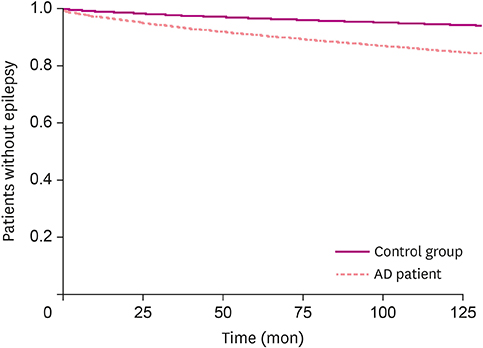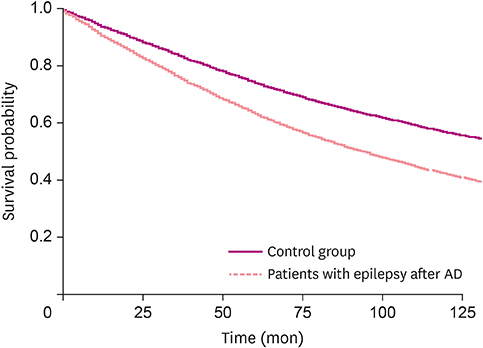Dement Neurocogn Disord.
2018 Dec;17(4):156-162. 10.12779/dnd.2018.17.4.156.
Association of Alzheimer's Disease with the Risk of Developing Epilepsy: a 10-Year Nationwide Cohort Study
- Affiliations
-
- 1Department of Neurology, National Health Insurance Service Ilsan Hospital, Goyang, Korea. jhlee@nhimc.or.kr
- 2Research Analysis Team, National Health Insurance Service Ilsan Hospial, Goyang, Korea.
- KMID: 2442786
- DOI: http://doi.org/10.12779/dnd.2018.17.4.156
Abstract
- BACKGROUND AND PURPOSE
Previous studies have reported conflicting results about the prevalence of seizures in Alzheimer's disease (AD). There are few epidemiological studies on this topic in Asia. Thus, the objective of this study was to examine demographic and clinical characteristics as well as incidence for seizures in AD patients compared to non-AD patients in a prospective, longitudinal, community-based cohort with a long follow-up.
METHODS
Data were collected from National Health Insurance Service-National Elderly Cohort (NHIS-elderly) Database to define patients with AD from 2004-2006 using Korean Classification Diseases codes G30 and F00. We performed a 1:5 case-control propensity score matching based on age, sex, and household income. We conducted Cox proportional hazards regression analysis to estimate the risk of epilepsy in AD patients.
RESULTS
In the cohort study, patients with AD had higher risk for epilepsy than those without AD, with hazard ratio of 2.773 (95% confidence interval [CI], 2.515-3.057). This study also showed that male gender and comorbidities such as hypertension, hyperlipidemia, diabetes, and chronic kidney disease increased the risk of developing epilepsy. Patients with AD had 1.527 (95% CI, 1.375-1.695) times higher mortality rate than those in the control group.
CONCLUSIONS
AD patients have significantly higher risk of developing epilepsy than non-AD patients.
Keyword
MeSH Terms
-
Aged
Alzheimer Disease*
Asia
Case-Control Studies
Classification
Cohort Studies*
Comorbidity
Epidemiologic Studies
Epilepsy*
Family Characteristics
Follow-Up Studies
Humans
Hyperlipidemias
Hypertension
Incidence
Male
Mortality
National Health Programs
Prevalence
Propensity Score
Prospective Studies
Renal Insufficiency, Chronic
Seizures
Figure
Reference
-
1. Vu LC, Piccenna L, Kwan P, O'Brien TJ. New-onset epilepsy in the elderly. Br J Clin Pharmacol. 2018; 84:2208–2217.
Article2. Stephen LJ, Brodie MJ. Epilepsy in elderly people. Lancet. 2000; 355:1441–1446.
Article3. Stefan H. Epilepsy in the elderly: facts and challenges. Acta Neurol Scand. 2011; 124:223–237.
Article4. Ghosh S, Jehi LE. New-onset epilepsy in the elderly: challenges for the internist. Cleve Clin J Med. 2014; 81:490–498.
Article5. Committee on Epidemiology of Korean Epilepsy Society. Epidemiological Study of Seizure and Epilepsy using Nationwide Database for Corean Epilepsy Patients. Seoul: Korean Epilepsy Society;2013.6. Pandis D, Scarmeas N. Seizures in Alzheimer disease: clinical and epidemiological data. Epilepsy Curr. 2012; 12:184–187.
Article7. Hauser WA, Morris ML, Heston LL, Anderson VE. Seizures and myoclonus in patients with Alzheimer's disease. Neurology. 1986; 36:1226–1230.
Article8. Hauser WA, Annegers JF, Kurland LT. Incidence of epilepsy and unprovoked seizures in Rochester, Minnesota: 1935–1984. Epilepsia. 1993; 34:453–468.
Article9. Friedman D, Honig LS, Scarmeas N. Seizures and epilepsy in Alzheimer's disease. CNS Neurosci Ther. 2012; 18:285–294.
Article10. Sherzai D, Losey T, Vega S, Sherzai A. Seizures and dementia in the elderly: Nationwide Inpatient Sample 1999–2008. Epilepsy Behav. 2014; 36:53–56.
Article11. Rao SC, Dove G, Cascino GD, Petersen RC. Recurrent seizures in patients with dementia: frequency, seizure types, and treatment outcome. Epilepsy Behav. 2009; 14:118–120.
Article12. Liu S, Yu W, Lü Y. The causes of new-onset epilepsy and seizures in the elderly. Neuropsychiatr Dis Treat. 2016; 12:1425–1434.13. Amatniek JC, Hauser WA, DelCastillo-Castaneda C, Jacobs DM, Marder K, Bell K, et al. Incidence and predictors of seizures in patients with Alzheimer's disease. Epilepsia. 2006; 47:867–872.
Article14. Cheng CH, Liu CJ, Ou SM, Yeh CM, Chen TJ, Lin YY, et al. Incidence and risk of seizures in Alzheimer's disease: a nationwide population-based cohort study. Epilepsy Res. 2015; 115:63–66.
Article15. Sjogren T, Sjogren H, Lindgren AG. Morbus Alzheimer and morbus pick; a genetic, clinical and patho-anatomical study. Acta Psychiatr Neurol Scand Suppl. 1952; 82:1–152.16. Scarmeas N, Honig LS, Choi H, Cantero J, Brandt J, Blacker D, et al. Seizures in Alzheimer disease: who, when, and how common? Arch Neurol. 2009; 66:992–997.17. Reeves MJ, Bushnell CD, Howard G, Gargano JW, Duncan PW, Lynch G, et al. Sex differences in stroke: epidemiology, clinical presentation, medical care, and outcomes. Lancet Neurol. 2008; 7:915–926.
Article18. Thompson HJ, McCormick WC, Kagan SH. Traumatic brain injury in older adults: epidemiology, outcomes, and future implications. J Am Geriatr Soc. 2006; 54:1590–1595.
Article
- Full Text Links
- Actions
-
Cited
- CITED
-
- Close
- Share
- Similar articles
-
- Association between nonalcoholic fatty liver disease and incidence of inflammatory bowel disease: a nationwide population‑based cohort study
- The Association Between Cancer and Neurodegenerative Diseases: A Retrospective Cohort Study Using the National Health Insurance Service-National Health Information Database
- Association between Alzheimer's Disease and Cancer Risk in South Korea: an 11-year Nationwide Population-Based Study
- The Association Between Neurodegenerative Diseases and Development of Type 2 Diabetes
- Increased risk of dementia in patients with primary Sjogren’s syndrome: a nationwide population-based cohort study



